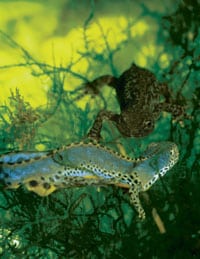Herping for amphibians in Germany.
A herping trip to the tropics — sure. But herping in Germany? That’s not the first destination that comes to mind. Well, let me take you on a little expedition to my native country, and you’ll see that it’s well worth a trip.
We may not have many herps in Germany; in fact, there’s only 20 amphibian species compared to the 190 in the United States. Some amphibians, like the plethodontid salamanders, which constitute a huge chunk of the U.S. herp list, are not found at all in Germany. Members of some groups like the treefrogs, true frogs, toads and spadefoot toads have representatives in both the German and North American herpetofauna. And there are some German herps, like the fire-bellied toads, that do not have any relatives in North America.
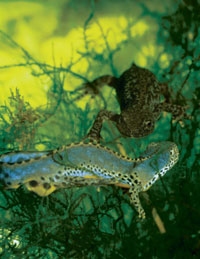
All photos by Gerlinde Höbel
North American and German Salamanders and Newts
There are six species of tailed amphibians in Germany, four newts and two salamanders. All members of the family Salamandridae, the German newts are related to the newts found in the United States. The salamanders, however, are not. German salamanders also belong to Salamandridae, while similar-looking North American salamanders belong to the family Ambystomatidae.
Despite being both members of the same family, the natural history of German newts (genus Triturus) and North American newts (genus Notophthalmus) differs in some key characteristics. Both groups start their lives as aquatic eggs and gilled, aquatic larvae. After metamorphosis, both leave the water and start a two- to three-year period during which their lifestyle is entirely terrestrial. During this time, they become sexually mature adults. The land-dwelling, immature stages of North American newts are called efts.

Upon reaching sexual maturity, the life history of German and American newts begins to differ. Notophthalmus newts return to the water and begin their fully aquatic adult stage. Once back into the water, they generally stay there for the rest of their lives. German Triturus newts also return to an aquatic phase, but only during mating season. After the end of the season, they leave the water to spend the rest of the year as terrestrial animals. They also overwinter in terrestrial hiding places. Come next breeding season, they go back to theaquatic stage and so forth.
In Germany, newts start breeding in spring. As temperatures start to climb, they begin their migration toward the breeding ponds. Upon starting the aquatic phase, both sexes undergo modifications to better adapt them to their new habitat. The tail flattens laterally to serve as a swimming aid, and they often develop finlike flaps between the fingers and toes. Males in particular grow crests and develop special mating coloration that can be quite spectacular.
The courtship behavior of German Triturus newts also differs somewhat from that of North American newts. Triturus males perform mating dances in front of the females. During these dances, they show off their colors and crests. More importantly, they use tail movements to waft pheromones toward females. Clasping of the female, which is part of the courtship of some Notophthalmus newts, however, never occurs. Insemination via a spermatophore, which the male deposits on the bottom of the pond, is similar in both groups. The females of both groups also deposit their eggs by wrapping them individually into leaves of submerged plants.
Triturus Newts
The first newt to arrive at the ponds in spring is the smooth newt (Triturus vulgaris). This species grows to about 4 inches in length. Both males and females show different shades of brown on the back, while the belly is lighter in color and often shows some orange. Males have dark spots all over their body, while this pattern is much reduced in females. They tend to have small dots rather than spots, if at all.
Upon reaching the ponds, males develop a medium-sized, undulated crest on their back and tail, and flaps between their fingers and toes. The lower part of the tail develops a characteristic stripe of red and blue. Females do not change their appearance much during the mating season.

Less frequently encountered is the palmate newt (T. helveticus). This species is small, hardly reaching 3½ inches in total length. The color is similar to the smooth newt, but without the dark spots. Males only grow a small, smooth crest and are easily distinguishable from smooth newts by their filamentous tail tip. Palmate newt females lack this special feature and are often very hard to tell apart from smooth newt females. Both species prefer small, densely vegetated ponds for reproduction.
The largest and most spectacular of the German newts is the warty newt (T. cristatus). They can reach a total length of up to 7 inches, but often stay quite a bit smaller. The belly is smooth with small black dots on an orange background. The dorsal coloration is dark brown, and the texture of the skin is very warty. What they may lack in coloration, however, they make up in body shape. During the breeding season, males grow huge crests that makes them look like little water dragons.
The prize for the most beautiful German newt, however, must go the alpine newt (T. alpestris). This is a medium-sized species, reaching a length of about 4½ inches. Males do not show off by developing huge crests, but by developing amazing colors. Even the females are quite pretty, with their bluish-mottled backs and orange bellies. During the terrestrial phase, the colors of the males darken and become quite similar to the coloration of the females.
Salamandra Salamanders
In contrast to the newts that need to spend some time in the water during the breeding season, German salamanders are quite independent from permanent bodies of water. Their ways of reproduction are quite different from those of North American ambystomatid salamanders, to which they bear only some superficial resemblance in body shape and coloration.
The black-and-yellow-spotted fire salamander (S. salamandra) is a large, stocky salamander that can reach up to 7 inches in length. They live in forested areas in moderate elevations. Mating takes place on land during the summer months. The following spring, after eight months of pregnancy, the female visits clean creeks and deposits several 1-inch long larvae into the water. These finish their development in the water and metamorphose into little salamanders in about four months. Fire salamanders get very old; captive animals are reported to have lived 50 years.
The jet-black alpine salamander (S. atra) reaches a length of 5 to 6 inches. As the name indicates, they inhabit mountainous regions. In this species, mating takes place on land as well, but there is no special mating season. Rather, mating occurs during the whole activity season, which can be quite short for high mountain populations.
Embryonic and larval development, as well as metamorphosis, take place within the female’s body. Depending on altitude, the whole process can take two to three years to complete. As a rule, only two 1½-inch-long baby salamanders are born. During development, nourishment for the larvae is provided by yolk of unfertilized eggs and later by secretions of the female. This specialized reproductive mode is an adaptation to the harsh climatic conditions in their alpine habitat.
A Lone Treefrog
Hard to believe, but there is only one species of treefrog in Germany. The European green treefrog (Hyla arborea) is a small (1½ inches) but pretty species. Its size and coloration resembles the North American green treefrog (H. cinerea), but H. arborea has a black lateral stripe rather than a white one.
During early summer, the frogs gather in ponds where males form nightly choruses to call for females. While calling, males often sit on top of aquatic vegetation floating in the water. Once a pair has formed, the female deposits several hundred eggs in small clumps attached to aquatic vegetation. The frogs spend the rest of the year in trees and bushes, often far away from ponds.
The Brown Ranids
There are six (well, five) species of true frogs of the family Ranidae in Germany: three brown ranids and three (actually two as you see later) green ranids. The three species of brown ranids are all explosive breeders in early spring. Their breeding season generally lasts less than a month. The green ranids have quite different life histories. They inhabit ponds and lakes, and are actively calling and reproducing throughout late spring to fall.
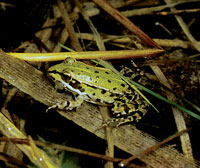
Among the first amphibians coming out of hibernation and starting their migration to the breeding ponds is the common frog (Rana temporaria). This relatively large species reaches around 4 inches in length. They may start calling and breeding when there are still ice sheets on parts of the pond. Although generally nocturnal outside the breeding season, in early spring they often call during the day when temperatures are somewhat higher. They often aggregate in huge choruses in the shallow parts of ponds or flooded meadows. The eggs are deposited in large clumps of several hundred eggs.
The common frog is one of the most common amphibians in Germany. They only gather in large choruses during their very short breeding season in early spring, however. For the rest of the year, they disperse and can live in a variety of habitat types, including forests, meadows and agricultural lands. Due to their secretive and nocturnal habits, they are not easily encountered outside the breeding season.
There are two other brown-colored ranids in Germany, but they are much less common. The moor frog (R. arvalis) is 2¼ inches. They gather in early spring to breed in boggy areas. The males are pretty spectacular because they turn a blue coloration during breeding season. Sadly, this species is threatened by extinction because most bogs have been drained for agriculture and only a very few suitable breeding habitats remain in their natural state.
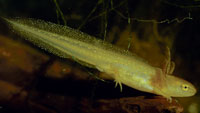
Finally, there is the agile frog (R. dalmatina). Very similar in appearance to the common frog, the agile frog is somewhat smaller, more slender and with longer legs. Its habitat preferences are more selective than those of the common frog. Agile frogs prefer to make their home in large tracts of deciduous forest.
The Green Ranids
Some time after the breeding season of the brown ranids is concluded, the green ranids start calling. They emerge in late spring and then continue calling during late summer and early fall. The largest of the green ranids found in Germany is the lake frog (R. ridibunda). This species reaches 4 to 5½ inches in length and can be considered the ecological equivalent of the North American bullfrog. They inhabit mostly larger bodies of water like lakes and will even enter slow-flowing rivers.
Growing to a maximum of 2½ inches, the pool frog (R. lessonae) is the smallest green ranid found in Germany. They prefer small water bodies like ponds or ditches with lots of aquatic vegetation as their prime habitat.
The most common species of green ranid, the edible frog (R. kl. esculenta), is actually not a real species at all. It is a cross between the lake frog and the pool frog, and as such is intermediate in size, appearance and habitat preferences. It is one of the most common and hardiest frogs. It adapts to many kinds of habitats and is one of the few species that colonizes ornamental garden ponds in urban areas.
Mating between a male and female edible frog is generally not successful. To reproduce, the edible frog has to mate with one of its parent species, in a complicated reproductive mode called “hybridogenesis.” During this process, either the pond frog or the lake frog part of the genome that each hybrid frog carries is discarded during the formation of the eggs. In areas where edible frogs live together with pool frogs, the pool frog genome is discarded and the lake frog genome remains. In a few populations where R. kl. esculenta is associated with the lake frog, it is the pool frog genome that is retained. The other half of the genome has to be substituted each year by backcrossing with the parental species.
This mode of reproduction is rare among vertebrates and has only been described for a few species of fish and amphibians. To identify such hybrid animals, the scientific name contains a “kl.” after the genus. It stems from the Greek word kleptos, meaning “thief,” and relates to the fact that hybrids have to “steal” the genome of one of the parental species to be able to procreate.
Lately another green ranid has been added to the German herpetofauna, the American bullfrog (R. catesbeiana). Although fears of the predatory bullfrog decimating populations of native amphibians have not yet been conclusively verified, it is never a good thing to have exotic species getting established in a habitat they don’t belong.
German Toads
Three toad species occur in Germany. The first to breed each year is the common toad (Bufo bufo), a brown toad that grows to about 4 inches. As the weather warms up in spring, toads start their breeding migrations. Because they are quite stubborn in their determination to return to their natal ponds to breed, many perish because they are overrun by cars as they try to cross roads that intersect their habitat. This prompts many nature protection groups each spring to set up fences and pitfall traps along roads to try to minimize the road fatalities.
Male common toads don’t wait to pair up with females until they reach the pond. While traveling, they often stop, rise up as high as they can on their short little legs and look out for females they may intercept on their way to the pond. Once they find a female, they pair up and let the females carry them the rest of the way to the breeding site. Only males that did not get lucky along the way join the breeding chorus that eventually forms at the pond.
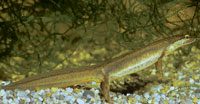
In my humble opinion, the European green toad (B. viridis) is the most beautiful toad in the world. They are 3½ inches and sport light green markings on a beige background. As a species adapted to steppe habitats, they prefer warmer climates, and in Germany are often found in sand and gravel pits.
Reaching only 2½ inches, the Natterjack toad (B. calamita) is the smallest toad found in Germany. This toad is easily identified by the yellow stripe that runs along the spine. Natterjack toads are unusual among toads because reproduction is not limited to one strong effort in spring, but can occur several times throughout the summer.
Whenever heavy rainfall fills up the ditches and puddles that they prefer to lay their eggs in, breeding may commence again. The partitioning of reproductive effort into several attempts a year is probably an adaptation to their choice of breeding habitat. Small ditches and puddles have the advantage that they heat up quickly and thus accelerate development of cold-blooded tadpoles. Also, they are generally free of fish, which are among the most dangerous predators to tadpoles.
On the other hand, there is always the danger that the puddles will dry out before the tadpoles complete their development. Tadpole development consequently is very quick, and under optimal conditions metamorphosis can be reached within one month. But even if the first batch of tadpoles dries up, by dividing their reproductive output into several batches, Natterjack toads have a better chance that at least some clutches make it each year.
Fire-Bellied Toads
There are two species of fire-bellied toads in Germany. The yellow-bellied toad (Bombina variegata) reaches a size of 1½ inches. This species occurs in the central and southern parts of Germany. They prefer small, muddy puddles and ditches that heat up quickly in the sun. Their dorsal coloration matches the sandy-tan color of their preferred habitat, and their bellies are mottled gray-black and yellow.
When threatened by a predator, they arch their back and draw back their arms and legs, exposing the yellow threat coloration of their bellies that announces that they are distasteful. This behavior, which is shown by all fire-bellied toads is called the “unken reflex,” unken being the German word for fire-bellied toads.
The second species, the European fire-bellied toad (B. bombina), is slightly smaller (1¼ inches). Their back coloration is a darker brown, and their bellies are mottled black and orange. They prefer heavily vegetated ponds and shallow lakes at lower elevations and are found only in eastern Germany.
Midwife and Spadefoot Toads
These two species do not occur in my corner of the country, so I have never seen them in the wild. Given their natural history, they are high on my like-to-find list.
The midwife toad (Alytes obstetricans) is a 2¼-inch, squat, brownish toad. This species practices an unusual type of parental care. Oviposition occurs on land, and the male winds the egg strings around his hind legs. There the eggs remain for three to six weeks while they undergo their early development. Once larvae are ready to hatch, the male carries them to water where they finish their development.
The common spadefoot (Pelobates fuscus) reaches up to 2½ inches and is another rather squat-looking, brownish toad. During the breeding season in late spring, males sit at the bottom of ponds and call under water. The tadpoles of this species are special, because they can grow to 4 inches, in some cases even 9 inches in length! The young toadlets are more moderately sized, measuring about 1 to 1½ inches upon metamorphosis. The common German name for this species translates to “garlic toad,” for the smell of their defensive secretion.
I have had a great time looking for herps in the United States while I was studying in Missouri. If you ever get to Germany, why don’t you take along a flashlight and try your luck at finding some of the cool amphibians that live across the big pond!

